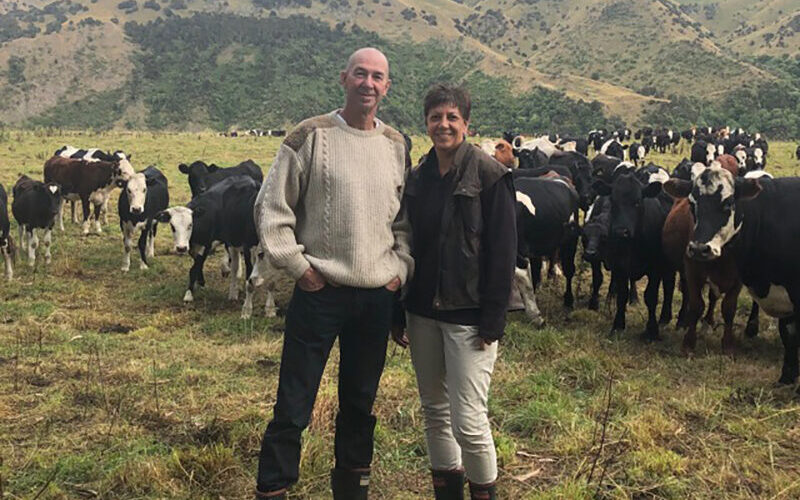By Craig Smith, a Hawke’s Bay beef farmer
Having farmed since the early 1970s with sheep and cattle on Taihape hill country and 50/50 share milking dairy cows in the Waikato, I think you could say I have pretty varied farming experience.
I went to Flock House in ’73 and Massey in ’79 and again in the ’90s to develop new skills, with the long-term goal of farm ownership.
Finding ways to accumulate enough money to buy a farm is a bit of a tall order, but after a failed marriage and a lot of wheeling and dealing, I purchased my “forever” farm 12 years ago.
It’s 282 hectares of easy country, located 50 minutes from Napier and one and a quarter hours Taupō. I’ve got the Mohaka River on the boundary, full of trout. Red deer, goats, turkeys, pheasants and quail thrive. It’s a regular hunters’ paradise.
I just love this place, but in order to farm it efficiently, there needed to be more paddocks.
I was taught from the beginning, that “fences grow grass”.
Being in the Bay, there is an abundance of broken vineyard posts, so, after a few dozen beers in the right hands, I had enough materials to carve 26 paddocks into 90, with two-wire electric.
The interesting thing was that the more post holes I dug, the fewer worms I found.
Being a bit of an observant bloke, I got the impression that if the worms aren’t interested in being here, then perhaps this is a rather unhealthy environment.
As a result I went on a bit of a learning exercise, trying to find out how to encourage an increase in the biology in my soil. I want everything to be healthy and happy on my farm.
There’s heaps of stuff on regenerative/organic farming on YouTube, so we watched everything we could, and adapted what we could to our environment.
We rear calves on cows, as a cheap way to get into our own stock, and take the calves through to killing weight at three years old.
This means we have five different classes of stock. We were keeping each class separate from the others, which meant that our rotation was not long enough to give the plants time to adequately recover.
We run all our stock in one mob now. Cows with four calves mothered on each, plus one-, two- and three-year-old cattle all run together. We move them two to three times a day, at times, into ideally 4000kg-plus of dry matter, with the object that they eat one-third and trample the rest.
From a conventional farmer’s perspective, this seems totally wasteful and contrary to everything that we’ve been taught.
However, as a result I haven’t put any fertiliser on the property for 12 years, and I’m on pumice, which will probably leach nutrients more than any other soil.
I put two dressings of lime on, early in the process, because I was told that I needed it, but it would appear that I don’t – I’m growing more grass than I ever have! We have worms now, dung beetles have turned up, there’s heaps of bugs, birds and all sorts of wildlife.
From what I have observed, under this system, giving our pasture plants heaps of time to recover after grazing seems to be the secret. Big plants with lots of leaves give a plant greater ability to photosynthesise (more leaves = more solar panels!). By lifting my residual up to 3000kg dry matter or more, by the time I get back to regraze there is a huge amount of lush plants along with seed head and mature stalk.
The animals can move through the pasture and choose a mouthful of clover or a bit of roughage depending on their desire.
Another benefit of the animals having access to both lush and mature plants is that their poo is much more solid, which I’m sure is kinder on their gut and intestines.
We try hard not to have animals overgraze plants, so that the ground is always covered and the plant doesn’t struggle to regrow.
Because the pasture is dense and tall we don’t need to drench –m nothing grazes down where the worms are. Besides, some drench, must come out in their poo, which would kill some of the biology in the soil.
One of the facts we learned from a webinar by Gabe Brown was that plants grow better in a diverse group, so we have started adding other species (by broadcasting) like chicory, plantain, Italian parsley, sunflower, strawberry clover, with more to come.
We are normally putting on between one and two kilograms of weight gain per day in the spring, so were not seeing any negative impacts from this change in system.
The fact that we are encouraging our pasture plants to grow much larger gives us total ground cover, protecting the soil from the sun, and a plant with deep roots that is much more tolerant to both hot and cold weather.
Another benefit is that all the grass that’s trampled catches any rain, and holds it in what could be loosely described as a blotter.
You can shove your hand under the trampled grass on a hot day and it’s cool. I did think that I’m possibly creating a great environment for facial eczema, but haven’t seen any signs of the symptoms at all.
Overall, I’m a total convert. It seems to me that as long as I keep the plants large and healthy, with lots of variation in species, everything else in the system thrives.
If you’re interested in taking a look at an alternative system, which has got to be good for the environment, flick me a text anytime on 0274 333 182.










